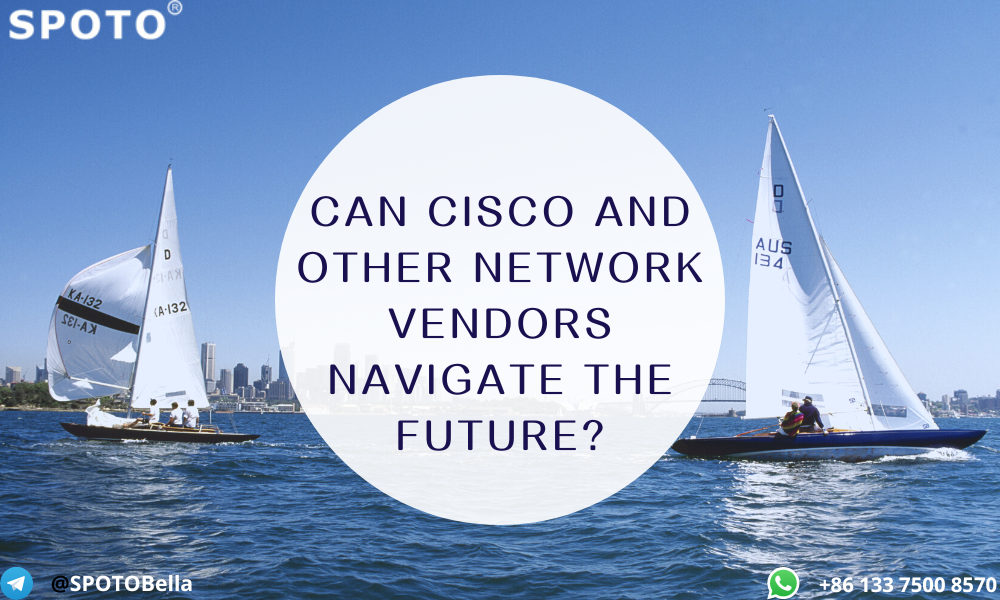Cisco experienced a lousy quarter; there’s no way about it. The question, therefore, is whether Cisco will be able to “go around it” in upcoming quarters, and the situation in this regard is quite complex. It will depend on how radical Cisco is ready to be in its approach to the future. If you wan pass Cisco exam in the first try, please contact SPOTO to gain the most useful study materials.

From the 1980s till about 2017, networking had its golden era. As with the vast majority of the golden ages, it has now ended and will never, ever return. Network equipment will not experience a resurgence in double-digit sales growth. This does not imply that network firms are doomed, merely that business strategies based on the golden period are. If corporations choose to stick with their business models for too long, they will eventually fail.
Spending on network equipment must be justified, meaning the equipment must create sufficient benefit to pay expenses plus the company’s internal rate of return margin (total “target ROI”). On the side of the service provider, the benefit is the income paid by clients, while for businesses, the use is the productivity achieved by the services. The benefits driving the acquisition of network technology have slowed for both corporations and service providers, and this is a network-side issue. It would need in-depth consideration of applications that may drive networks, but there has been little or no coordinated attempt to promote, much less generate, such review.
Robbins of Cisco provides our point of departure: “If the previous year has taught us anything, it’s that we must constantly be agile.” This is the lesson of the previous ten years. According to my research, this is how long the market has been influenced by the trends impacting network buying decisions (and these blogs have documented it). The market has changed, not is changing. There is no turning back since the demand-side transition could never be completed quickly enough to allow vendors to continue executing their previous box-centric sales strategies.
Cisco has acknowledged this for some time, but their identification has been more symptom-based than root-cause-based. Almost 15 years ago, I presented Cisco with a detailed picture of IT expenditure and how it moved over long periods and in response to various stimuli. Still, they refused to listen (competitor Juniper did not either). But even though Cisco can only see a symptomatic vision of the future, they have at least identified some of the necessary bandages. You must adopt a greater-as-a-service model. Software is more important than hardware. All of this is true, but Cisco would benefit much by understanding why this is required. It might lead to their reaction and allow them to handle the hazards each answer poses, as every response poses a risk.

As a result of buyer anxieties about lock-in and stranded assets, the transition to as-a-service is occurring. If I can purchase connection rather than technology on a short-term contract, I am in the driver’s seat. Therefore, I would choose providers with a non-traditional expense-based strategy, correct? Yes, and suppliers who provide what the consumer desires will subsequently lose account management and be subject to their commoditization. That is the danger.
The future of networking at the primary level is two-dimensional virtualization. First, the end of connections is virtual networks that enable ad hoc connectivity in community form or globally. SD-WAN (which Cisco does provide) is one example, although Cisco’s solutions pale in comparison to those of feature-leaders (like 128 Technology). Second, the virtualization of platforms to produce white-box-and-software networking is imminent, and no present box-network provider can realistically win this game. These developments will eliminate any prospects for “network equipment” if networking is not changed by new advantages.
Does this imply that Cisco and other suppliers should lie on their backs with roses on their chests? Perhaps not necessarily. Let’s return to an earlier point: Lock-in. Nobody is afraid of being stuck on the best response or strategy. The issue emerges when there is no accepted correct or optimum response. The concept of as-a-service stems from the reality that networks are ultimately just pumping 1s and 0s, leaving little room for difference. However, buyers and sellers are aware of the reduction in network advantages and would prefer to remedy it. If networks cannot increase productivity, they like to know what can, rather than just reject network expenditures. First, providers such as Cisco must raise their presentations to the level of network applications rather than network technology.
There have been companies that have attempted this, but “network applications” cannot refer to hypothetically desirable content supported by unnamed products/vendors. What is required is a driver of genuine advantages and benefits that are realizable without collaborating with a broad and developing community of products and suppliers. Alternatively, the seller must cultivate the community and develop the apps.
Each wave of growing network advantages and expenditures has been attributable to an IT development rather than a network development. Even the expansion of the Internet would not have been conceivable without the proliferation of personal computers. Because Cisco is one of the very few network suppliers with IT credentials, it should embrace this. Cisco has underutilized its servers and software business; addressing this issue should be Cisco’s top priority and a signal to other industry vendors. If the software is the future, more money will be spent on IT equipment and less on large or small network boxes.
What will future customers pay for, i.e., pay more for? Not bandwidth; we know mobile subscribers anticipate no cost increase for 5G. To keep rates low, users prefer to cluster towards the lower end of wired broadband services. At the same time, paying for streaming video, streaming audio, and other activities. The future of “networking” involves transitioning from being the delivery vehicle to becoming what someone purchased.
The real competition for network suppliers such as Cisco comes from IT vendors, particularly software and platform vendors such as Red Hat and VMware, as well as the public cloud. Long-term network manufacturers must enter the former field, while Cisco and others are attempting to adapt the as-a-service business model shortly. Can Cisco, or any other network provider, create this IT-centric vision, productize it, and realign its sales and marketing to make it successful? Against well-established, credible rivals?
I believe Cisco must attempt. No redemption is available for the big-box network industry. Open-model networking will eventually infiltrate the corporate and data centers. Cisco is uniquely positioned to connect the past (golden days) with the future (experience networks, not connection networks). They cannot maintain this position for long. Know more information, please contact SPOTO.

Comments